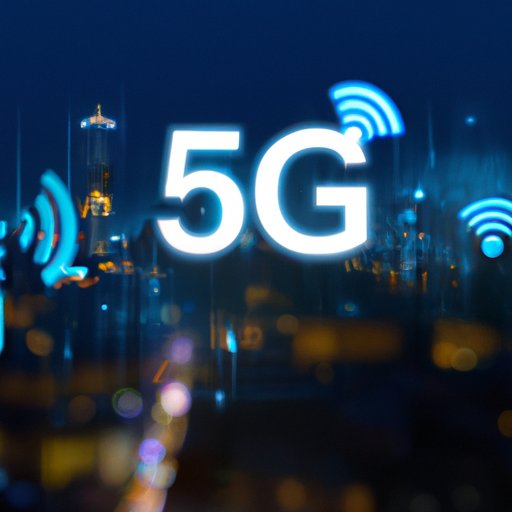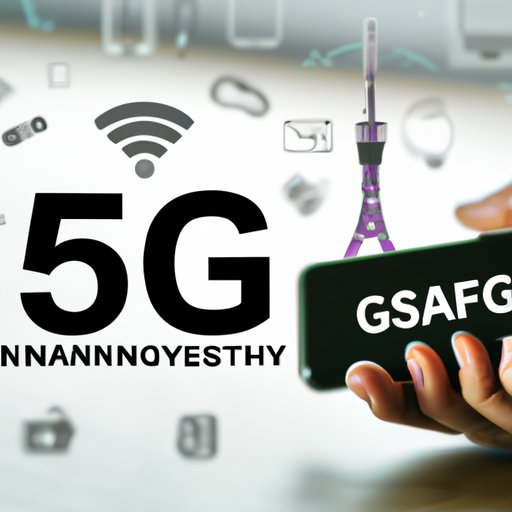Introduction
5G technology is the fifth generation of wireless network technology, and the most recent development in the field. It promises to revolutionize the way we communicate, interact, and do business, with much faster download speeds, improved latency, and better overall connectivity. This article will explore what 5G technology is, the benefits it brings, the potential risks, and how it compares to previous generations of wireless networking.
What is 5G Technology?
According to a study by GSMA Intelligence, 5G is “the next generation of mobile networks that will enable faster data speeds, lower latency, and more reliable connections.” This means that users can expect faster download speeds, improved latency, and better overall network performance. 5G technology also offers enhanced features such as Internet of Things (IoT) support, increased capacity, and better coverage. In addition, 5G networks are designed to be more efficient, using less energy than previous generations of networks.
Benefits of 5G Technology
The benefits of 5G technology are far-reaching, and include improved connectivity, faster download speeds, improved latency, and enhanced consumer experiences. According to a report by Deloitte, “5G will open up new possibilities for businesses, consumers, and society as a whole.” The report goes on to cite the growth of the IoT industry, the development of smart cities, and the ability to deliver high-quality video streaming as some of the key benefits of 5G.

How 5G Technology is Changing the World
5G technology is already beginning to have a significant impact on businesses and industries around the world. For example, the improved speed and reliability offered by 5G networks has enabled businesses to take advantage of new technologies such as AI, machine learning, and edge computing. In addition, 5G networks are allowing businesses to increase their efficiency and reduce their costs through advanced automation and analytics.
5G technology is also improving the way people connect and interact with each other. With faster download speeds and improved latency, users can access content and services more quickly, resulting in a better overall experience. In addition, 5G networks are enabling new applications and use cases, such as augmented reality and virtual reality, which are transforming the way people interact with their environment.
Finally, 5G technology is enhancing consumer experiences. With improved speed and reliability, users can access content and services more quickly, resulting in a better overall experience. In addition, 5G networks are enabling new applications and use cases, such as augmented reality and virtual reality, which are transforming the way people interact with their environment.

Understanding the Potential Risks of 5G Technology
While 5G technology offers many potential benefits, there are also potential risks associated with the deployment of 5G networks. One of the most commonly cited concerns is security. 5G networks are vulnerable to hacking and malicious attacks, and could potentially be used to disrupt critical infrastructure or steal confidential information.
In addition, there have been concerns raised about the potential health impacts of 5G networks. While research into this area is still ongoing, some studies have suggested that exposure to high levels of radiofrequency radiation from 5G networks could be linked to an increased risk of certain health problems.
Comparing 5G Technology to Previous Generations of Wireless Networking
It is important to understand how 5G technology compares to previous generations of wireless networks. The evolution of wireless networking began with 1G, which was designed primarily for voice calls. 2G introduced text messaging and data services, while 3G brought higher data speeds and improved coverage. 4G was designed to handle data-intensive applications such as streaming media and video conferencing. 5G, on the other hand, is designed to provide faster speeds, lower latency, and improved capacity.
When compared to previous generations of networks, 5G offers several advantages. For example, 5G networks are capable of delivering speeds up to 20 times faster than 4G networks, with latency as low as 1 millisecond. In addition, 5G networks are designed to be more efficient, using less energy than older networks. Finally, 5G networks are designed to support the growing demand for IoT devices, enabling them to connect to the network more quickly and reliably.
Conclusion
5G technology promises to revolutionize the way we communicate, interact, and do business. It offers improved speed, reliability, and capacity, making it ideal for businesses and consumers alike. However, there are also potential risks associated with 5G networks, including security and health concerns. Ultimately, it is important to weigh the potential benefits and risks of 5G technology before deciding whether or not to deploy it.
In conclusion, 5G technology is the most recent development in the field of wireless networking, and offers a range of benefits over previous generations of networks. It is capable of delivering faster speeds, improved latency, and better overall performance, while also supporting the growing demand for IoT devices. However, it is important to understand the potential risks associated with 5G networks, such as security and health concerns, before deciding whether or not to deploy it.
(Note: Is this article not meeting your expectations? Do you have knowledge or insights to share? Unlock new opportunities and expand your reach by joining our authors team. Click Registration to join us and share your expertise with our readers.)
